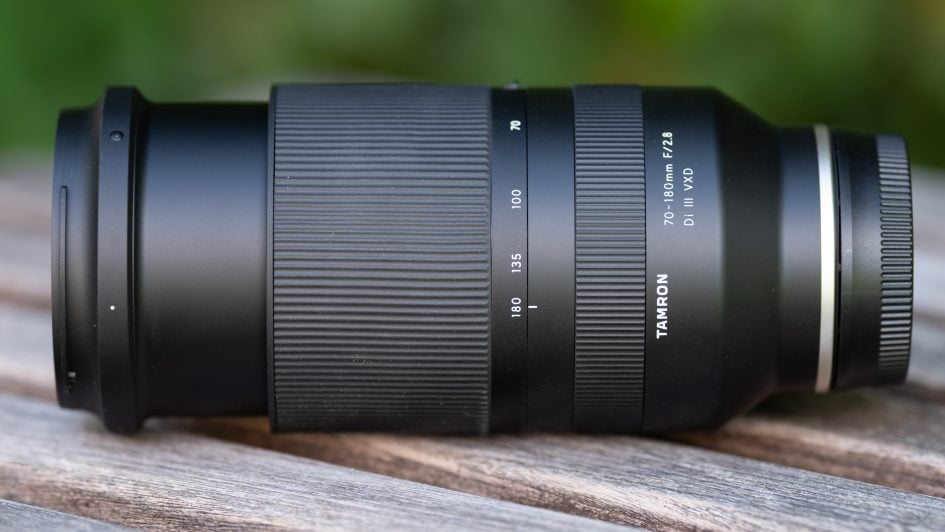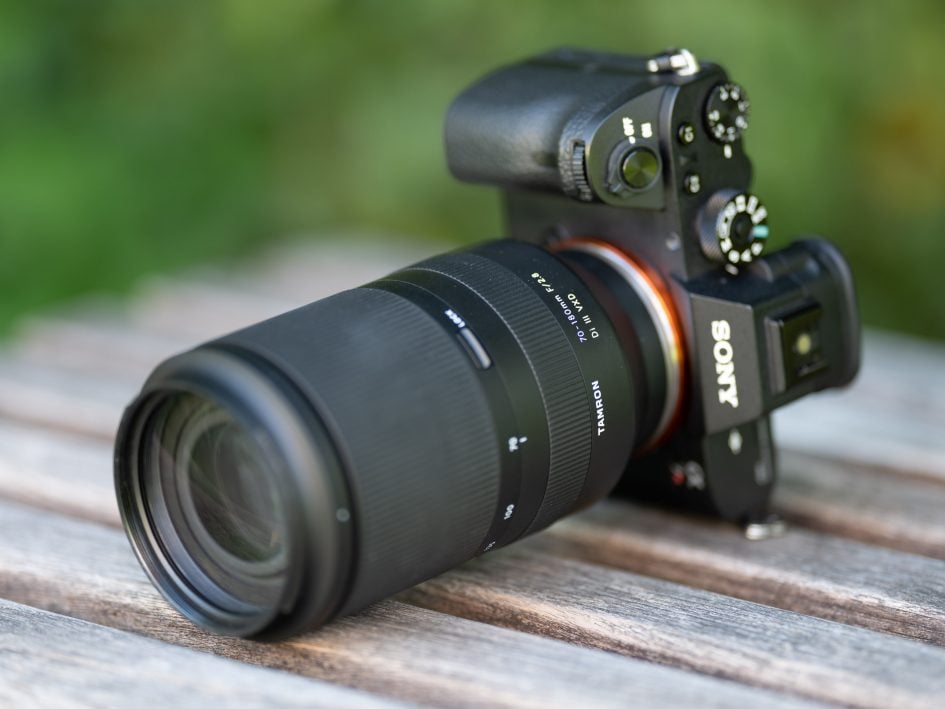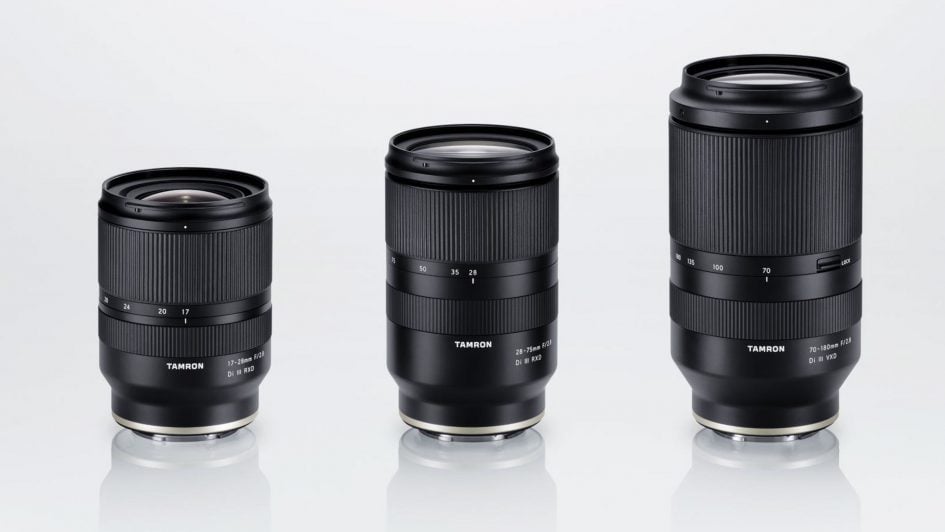Tamron 70-180mm f2.8 Di III VXD review
-
-
Written by Thomas
Intro
The Tamron 70-180mm f2.8 Di III VXD (model A056) is a telephoto zoom designed for Sony’s Alpha mirrorless cameras and corrected for full-frame sensors. Announced in April 2020, it complements Tamron’s other zoom lenses for E-mount with a fast f2.8 focal ratio: the 17-28mm f2.8 Di III RXD and the 28-75mm f2.8 Di III RXD.
Physically, the 70-180mm f2.8 Di III shares the same small 67mm filter thread with the shorter zooms and it is only 81mm (3.2in.) diameter wide and 149mm (5.9in.) long – but extends when zoomed to 180mm focal length. It weighs only 800g (28 oz.) and can go down to a maximum magnification of 1:1.8 with manual focus at 70mm focal length. Interestingly the lens has no optical stabilization but relies solely on the image stabilization provided by the Sony Alpha mirrorless cameras.
The Tamron 70-180mm f2.8 Di III is listed at 1499 EUR (incl. 19% VAT) / 1199 USD / 1349 GBP. In my review I’ve compared the new lens to the Sony FE 70-200mm f2.8 G Master OSS. PS – if you’re interested in the other two f2.8 zooms for E-mount in Tamron’s line-up check out my in-depth reviews: Tamron 17-28mm f2.8 Di III review, Tamron 28-75mm f2.8 Di III review.
Facts from the catalog
Let’s compare the Tamron 70-180mm f2.8 Di III (“Tamron III” for short) to the Sony FE 70-200mm f2.8 G Master OSS (“Sony” for short) and its DSLR sibling the Tamron SP 70-200mm f2.8 Di VC USD G2 (“Tamron G2”) which can be used via mount-converter. As usual I’ve rated the features with a [+] (or [++]), when it’s better than average or even state of the art, a [0] if it’s standard or just average, and [-] if there’s a disadvantage.
Size (diameter x length): 81 x 149mm (3.2 x 5.9in.) plus 46mm for the lens hood (94mm diameter). The new Tamron III is much smaller than the Sony at 88 x 198mm (3.5 x 7.9in) + 83mm lens hood. Zooming the Tamron III to 180mm focal length extends the lens by 29mm which is still shorter than the Sony which does not change its length during zooming. The Tamron G2 is 88 x 191mm (3.5 x 7.5in) + 89mm lens hood + 28mm for the mount-converter. [+]
Weight: 800g (28 oz.) plus 46g for the lens hood. That’s only 54% of Sony’s 1473g (52oz.) + 95g lens hood. The detachable tripod foot adds another 78g to the Sony. The Tamron G2 is 1370g (48.3oz.) + 57g lens hood + 109g for the detachable tripod collar and some 100+g for the mount-converter. [+]
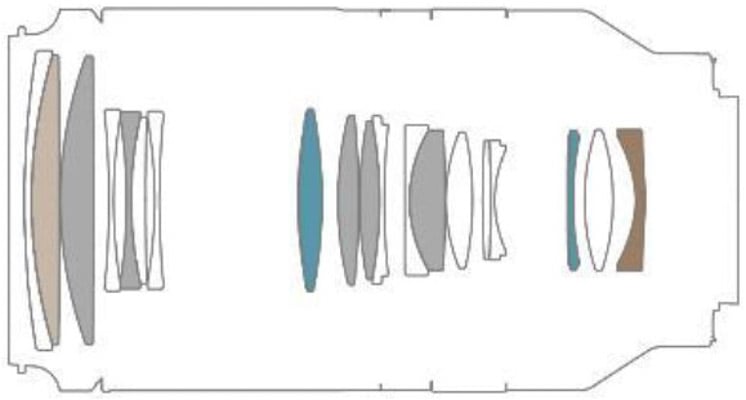
Optics: The Tamron 70-180mm f2.8 Di III has 19 elements in 14 groups including 6 special dispersion elements and 3 aspherical elements. This is a slightly simpler design than the Sony with 23 elements in 18 groups. Both lenses have fluorine-coating on the front element to repel water, dust, and dirt and make cleaning easier. The Tamron G2 has 23 elements in 17 groups and does not employ fluorine-coating. [+]
Closest focus distance is 0.26m (0.9ft.) at 70mm focal length with manual focus and 0.85m (2.8ft.) at 180mm focal length. A very good maximum magnification of 1:1.8 is achieved at 70mm focal length albeit with a very short working distance of 9cm (lens hood detached). At 180mm focal length maximum magnification is still a very useful 1:4.1 with a working distance of 0.61m. The Sony achieves its maximum magnification of 1:3.6 with manual focus at 200mm focal length and 0.89m minimum object distance. This leaves 0.67m working distance between front lens and object. The Tamron G2 goes down to 1:5.6 magnification at 0.85m distance.
How close do you have to get for 1:10 magnification e.g. for a very tightly cropped head-shot? At its longest focal length the Tamron III achieves 1:10 at a distance of 1.88m (6.2ft.) while the Sony has a longer reach of 2.14m (7.0ft.) due to its longer focal length. [+]
Teleconverter: There is no teleconverter for the Tamron III and you cannot use Sony’s 1.4x and 2.0x teleconverter with the Tamron III. For the Tamron G2 there are specific 1.4x and 2.0x teleconverter from Tamron. [-]
Filter-thread: The Tamron 70-180mm f2.8 Di III shares the same 67mm filter-thread with its shorter siblings the 17-28mm f2.8 Di III and 28-75mm f2.8 Di III which is very convenient – and saves costs. The Sony and the Tamron G2 take 77mm filters. [+]
Image stabilization: The Tamron III does not offer optical stabilization. The lens solely relies on the sensor-based image stabilization of the Sony Alpha mirrorless cameras. The Sony zoom lens has optical image stabilization built in which works together with the sensor-based image stabilization of a Sony Alpha body. The Tamron G2 also offers optical stabilization. [0]
Auto focus: Yes with built-in AF drive. Manual-focus override is by simply turning the dedicated focus ring. The focus ring has a variable gearing (like Tamron’s shorter f2.8 zooms for E-mount) which allows for very precise manual focus when turned slowly but cannot be switched to linear gearing. Which makes smooth focus pulling for videographers almost impossible. The Sony has linear gearing with a turn of 100 degrees, the Tamron G2 turns 130 degrees and has the added benefit of a distance- and dof-scale. [+]
Lens profile: The lens comes with a lens profile for vignette-, CA- and distortion-compensation which can be controlled from the camera. Adobe’s RAW converter (as of version 12.2.1) does not recognize the profile completely: vignette is compensated as it was set in camera (but you cannot switch between off and auto in post-processing) while CA-compensation is always ON, distortion compensation always OFF. To get rid of the distortions in RAW files you need to activate the Adobe supplied lens profile. [+]
Covers full frame/FX or smaller. Same with the Sony or Tamron G2. [+]
Price: 1499 EUR (incl. 19% VAT) / 1349 GBP / 1199 USD. This looks like a pretty high price for a lens without optical stabilization and only 180mm maximum focal length. But the Sony goes for 2700 EUR / 2150 GBP / 2600 USD. The Tamron G2 can be had for 1120 EUR / 1150 GBP / 1200 USD but needs a mount-converter. [0]
The Tamron III comes without a pouch but the lens hood is included and reversible for transport. The Sony has a nicely padded lens case plus strap and a tripod-collar. And its lens hood has a slider through which a polarizing filter can be orientated. The Tamron G2 comes with a soft pouch and a removable tripod-collar that has an Arca-Swiss style tripod interface. [0]
Aperture ring and other control elements: The Tamron III has no aperture ring nor the usual AF/MF switch but offers a zoom-lock to prevent the zoom from extending when in the 70mm position. The Sony also has no aperture ring but offers a focus hold button, a focus limiter switch (full/3m) plus switches to control image stabilization and AF/MF. The Tamron G2 is similar to the Sony except that it has no focus hold buttons. [0]
Sealing: yes, a rubber grommet at the lens-mount plus further special weather-sealing throughout the construction, just like the Sony and Tamron G2. [+]
The score in the “features-department” is 1[-]/4[0]/9[+] which makes the new Tamron 70-180mm f2.8 Di III look like a well rounded design. Its prominent features are its small size and weight plus the maximum magnification of 1:1.8. It’s biggest disadvantage is that the lens cannot be used with teleconverters.
Three Tamron f2.8 zoom lenses for E-mount
Above from left to right: Tamron 17-28mm f2.8 Di III, 28-75mm f2.8 Di III, 70-180mm f2.8 Di III
Alternatives
Currently there’s only one other f2.8 telephoto zoom available for Sony’s E-mount. Other alternatives all have a slower focal ratio or have to be used via adapter adding to the size and weight of the combo.
- Sony has the FE 70-200mm f2.8 GM OSS from 2016 which still costs 2700 EUR / 2600 USD. The lens is a typical design for professional users offering optical image stabilization with two modes, a focus-lock button, focus limiter, and a detachable tripod foot. It’s 200mm long and weighs 1.5kg. For more information see my Sony FE 70-200mm f2.8 GM OSS review-so-far.
- Sony also has the FE 70-200mm f4.0 G OSS from 2013 which is similarly featured but at 175mm, 840g, and 1100 EUR / 1500 USD shorter, lighter, and cheaper than its f2.8 sibling. It earned a Highly Recommended in my Sony FE 70-200mm f4G OSS review.
- Sigma offers the stabilized Sigma 70-200mm f2.8 DG OS HSM Sports (1270 EUR / 1260 USD) from 2018. It is not (yet) available for E-mount but can be used via Sigma’s own Canon EF to Sony E MC-11 mount-converter. It’s a typical DSLR design with mechanically coupled focus ring, a focus and dof scale, focus-lock button, non-detachable tripod mount with an Arca-Swiss style interface, and optical image stabilization. It is 203mm long and 1.8 kg heavy (without converter). Check back soon for my upcoming Sigma 70-200mm f2.8 Sports review.
- Tamron’s stabilized SP AF 70-200mm 2.8 Di VC USD G2 for about 1200 EUR/USD is a DSLR design available in Canon and Nikon mounts and can be used via converter on a Sony Alpha camera. The lens has a removable tripod-collar with an Arca-Swiss style tripod interface plus a focus limiter. It is 194mm long, weighs 1.5kg (without converter), and earned a recommendation in my Tamron SP 70-200mm f2.8 VC G2 review from 2017.
Two tele-photo zoom lenses for E-mount
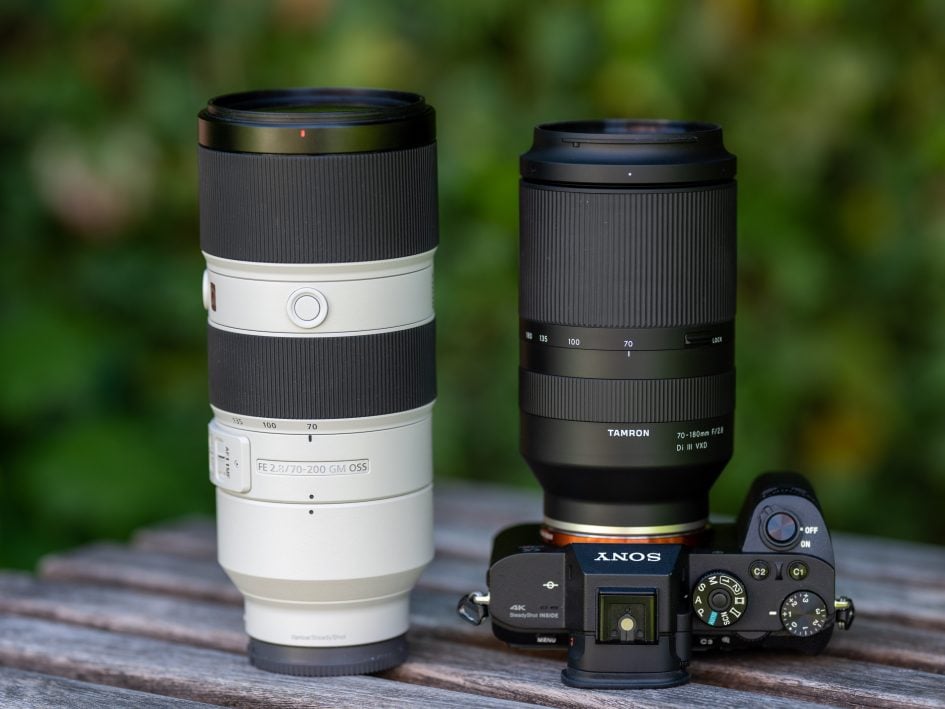
Above: Sony FE 70-200mm f2.8 GM OSS (left), Tamron 70-180mm f2.8 Di III (right)
The alternatives all have the benefit of reaching to 200mm focal length which is 10% longer than the new Tamron. Here is the angle of view that the new Tamron 70-180mm f2.8 Di III covers with its 2.6x zoom:
Above: Tamron 70-180mm f2.8 Di III coverage on Sony A7R II (FF) body at 70mm (left) and 180mm (right), Distortion Compensation ON
Compare this to the coverage of Sony’s 2.9x zoom:
Above: Sony FE 70-200mm f2.8 GM OSS coverage on Sony A7R II (FF) body at 70mm (left) and 200mm (right), Distortion Compensation ON
Should you worry about the missing 20mm on the long end of the new Tamron? Well, you can always crop 10% into the image to achieve the same angle of view as a 200mm lens. This reduces the resolution of a 42MP image shot at 180mm to 34MP which is only notable if you look very close. See an example on the next page.
Focus and zoom
Focus accuracy and repeatability is critical to consistently produce sharp shots. Repeatability (the accuracy of focus on the same subject after repeated focus-acquisition) of this lens at 180mm focal length is very good (measured 98.8% in Reikan FoCal) with no outliers over a series of 40 shots. There is no focus variation whether the lens focuses from a closer distance or from infinity and I seldom detect some hunting. At 180mm focal length the lens focuses in around 0.8 sec from infinity to 1.88m (1:10 magnification), which is not very fast and a bit slower than the Sony FE 70-200mm f2.8 GM OSS at 0.7 sec.
The zoom ring turns through 65 degrees the way Sony users are used to and has a 49mm wide rubber surface with a good grip. It turns with medium resistance and can hardly be operated with one finger. The lens shows only a little zoom creep but the zoom lock at 70mm can prevent even that. The focus ring is 16mm wide, located at the back of the lens, and moves smoothly.
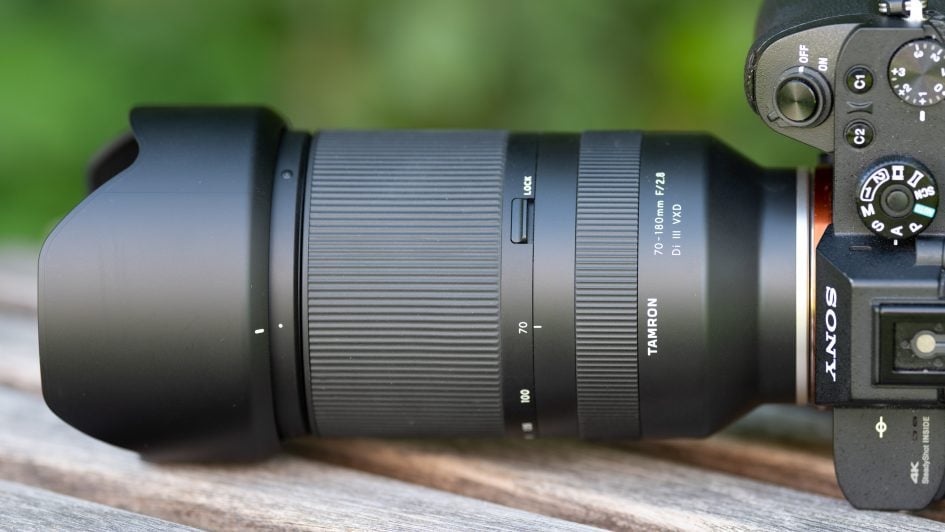
AF-operation of the new lens and image stabilization of the A7R II is inaudible from the outside and if you record video with the built-in microphone the AF-drive produces no noise. When the lens is powered down the focus group inside the lens slides back and forth freely as the focus drive is not engaged. That makes a low thunking sound and you can feel the focus group moving around.
As you pull focus, you’ll notice some focus breathing: the image becomes more magnified at closer focusing distances. When I adjusted the focus from infinity to 1.88m on the new Tamron at 180mm focal length, I measured a 4% increase in magnification. This is quite visible and might annoy some videographers but it is a much smaller effect than the Sony FE 70-200mm f2.8 GM OSS shows with its 11% increase in magnification. The same test at 70mm focal length produced only a 0.4% increase.
I also tested whether Tamron’s newest zoom lens allows you to change the focal length without altering its focus. This characteristic is called parfocal. I manually focused the lens at 180mm and then slowly zoomed back to 70mm checking focus on the way. The 70-180mm f2.8 Di III did keep its focus perfectly. Just don’t forget to focus the lens at the long end, not the wide end.
Image stabilization
To test the effectiveness of the image stabilization with the Tamron 70-180mm f2.8 Di III on an A7R II body, I did a series of 140 test-shots hand-held at 180mm focal length. I tested with shutter speeds from 1/200 of a second down to 1/6 sec. I used the shots at 1/200 sec with SteadyShot=off as reference of how good my hand-holding was at the time of the test and Reikan FoCal did the chore of evaluating the sharpness of all shots.
Here’s the results: With SteadyShot=on the combo produced results down to 1/50 sec (2 stops) which were at least as sharp as at 1/200 sec with SteadyShot=off. At 1/25 sec (3 stops) I had 3 out of 20 shots which were worse than the results at 1/200 with SteadyShot=off but 80% of the shots were very usable. At 1/12 sec (4 stops) results became quite erratic with 50% clearly blurred images and at 1/6 sec (5 stops) only 20-25% of the shots were usable – but only for smaller output sizes. This is a 3 stop advantage from the sensor-based image stabilization built into the Sony A7R II camera at 180mm focal length – which probably becomes even better at shorter focal lengths. Interestingly the Sony FE 70-200mm f2.8 GM with its built-in optical stabilization OSS did not produce much better results at 200mm focal length.
Next check out my quality results!
Check prices on the Tamron 70-180mm f2.8 Di III VXD at B&H, Adorama or WEX. Alternatively get yourself a copy of my In Camera book or treat me to a coffee! Thanks!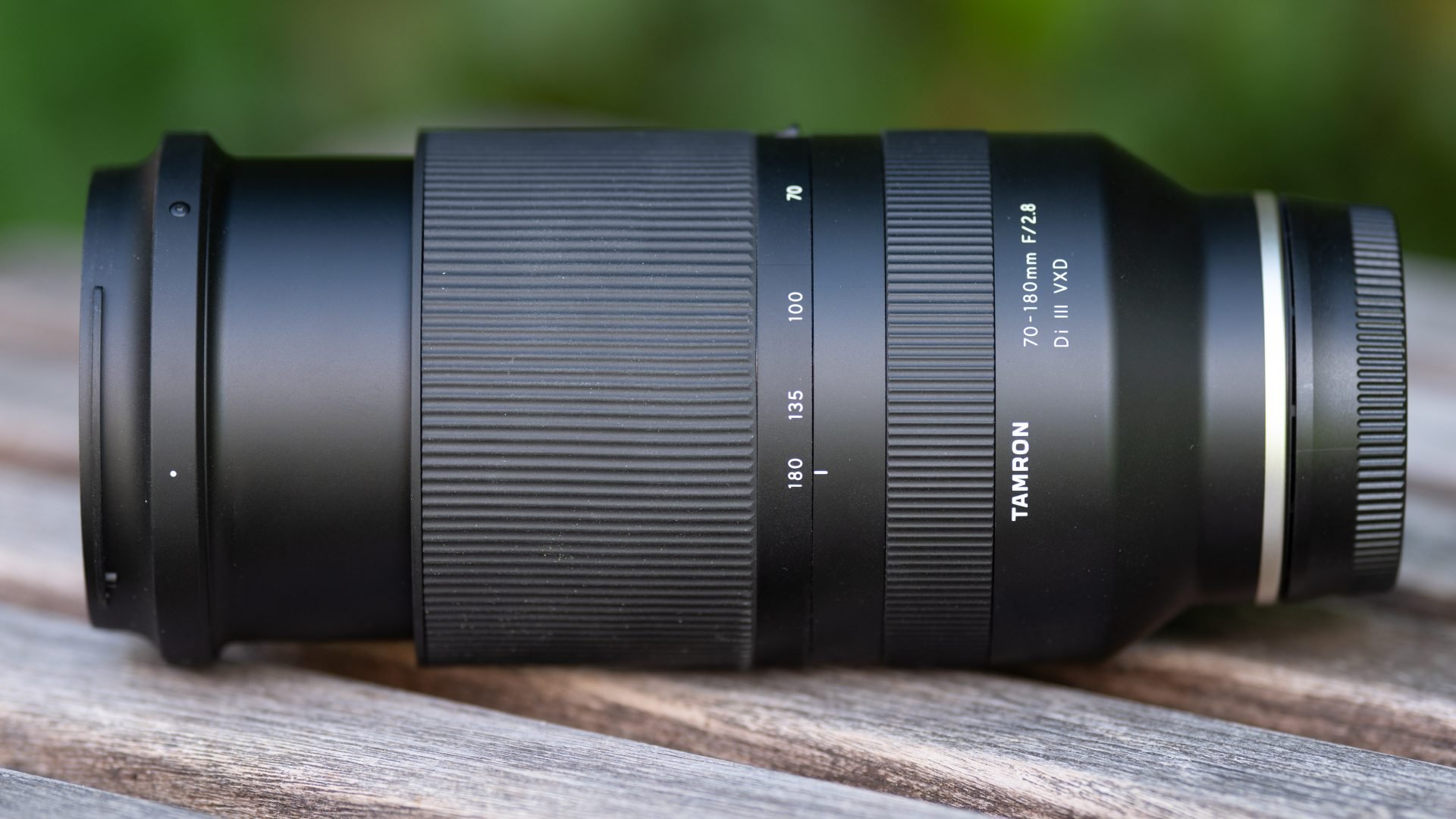
 The Tamron 70-180mm f2.8 Di III is a small and light telephoto zoom with a constant f2.8 aperture that's designed for Sony’s E-mount mirrorless cameras. It produces very good image quality including a soft Bokeh and very usable close-up performance in a package that is much smaller, lighter, and cheaper than Sony's FE 70-200mm f2.8 GM. It may not have all the bells and whistles of Sony's professional zoom lens and its biggest disadvantage is the incompatibility with teleconverters. But it still is a compelling alternative to the Sony and clearly earns a recommendation!
The Tamron 70-180mm f2.8 Di III is a small and light telephoto zoom with a constant f2.8 aperture that's designed for Sony’s E-mount mirrorless cameras. It produces very good image quality including a soft Bokeh and very usable close-up performance in a package that is much smaller, lighter, and cheaper than Sony's FE 70-200mm f2.8 GM. It may not have all the bells and whistles of Sony's professional zoom lens and its biggest disadvantage is the incompatibility with teleconverters. But it still is a compelling alternative to the Sony and clearly earns a recommendation!